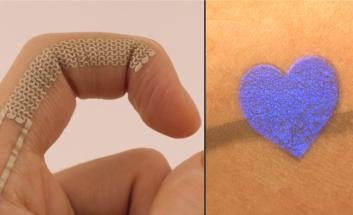Fingers, knuckles and even birthmarks are becoming control elements: Scientists have invented ultra-thin, electronic tottoos for the remote control of mobile devices, which can be applied to distinctive body locations. They can be used by touching, squeezing or pulling them. The advantage: The body locations are so familiar, that the user can use them even with closed eyes.
Since 2015 the developers around Jürgen Steimle of the University of Saarland In Saarbrücken Germany have showed, that the human skin can be used as area of input for mobile devices: Together with American scientists they have managed to develop a flexible silicon called "iSkin" containing conductive electronic sensors: Stickers to be used on the skin, which are sensitive for touch. Currently the concept can only be used at specific parts of the body, because it needs a relatively smooth area. Further, the stickers are kinda big.
We would like to use areas of the body, where no interaction was possible before.
This goal represents a huge challenge:
It is very complicated to place electronic devices to the human skin while keeping them assimilated to the bones, knuckles or micro structures like wrinkles.
The computer scientist Martin Weigel tells us.
"iSkin" advanced to "SkinMarks"

Control with the forefinger or a birthmark in form of a heart.
(Image: University of Saarland)
Remote control with the forefinger, or with a birthmark in form of a heart
The main advantage of the "SkinMarks" system is familiarity of users with their own body, the scientists say.
If you have to push the first knuckle of your left hand, you know where it is located in an intuitive way.

Crazy robot style...
click here!This post received a 3.9% upvote from @randowhale thanks to @n3bul4! For more information,